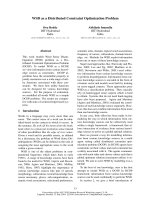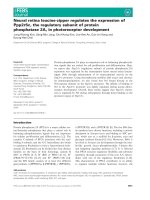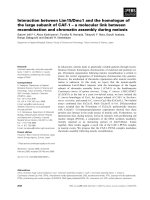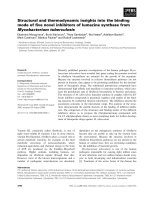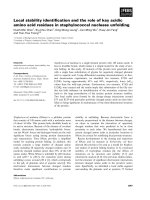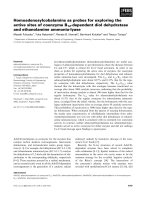báo cáo khoa học: " Worry as a window into the lives of people who use injection drugs: a factor analysis approach" pot
Bạn đang xem bản rút gọn của tài liệu. Xem và tải ngay bản đầy đủ của tài liệu tại đây (193.61 KB, 6 trang )
BioMed Central
Page 1 of 6
(page number not for citation purposes)
Harm Reduction Journal
Open Access
Research
Worry as a window into the lives of people who use injection drugs:
a factor analysis approach
Heidi Exner
1
, Erin K Gibson
1
, Ryan Stone
2
, Jennifer Lindquist
2
,
Laura Cowen
2
and Eric A Roth*
3
Address:
1
AIDS Vancouver Island, 1601 Blanshard Avenue, Victoria, British Columbia, V8W 2J5, Canada,
2
Department of Mathematics and
Statistics, PO BOX 3060 STN CSC, Victoria, British Columbia, V8W 3R4, Canada and
3
Department of Anthropology, University of Victoria, PO
Box 3050, STN CSC, Victoria, British Columbia, V8W 3P5, Canada
Email: Heidi Exner - ; Erin K Gibson - ; Ryan Stone - ;
Jennifer Lindquist - ; Laura Cowen - ; Eric A Roth* -
* Corresponding author
Abstract
Background: The concept of risk dominates the HIV/AIDS literature pertaining to People Who
Use Injection Drugs (PWUID). In contrast the associated concept of worry is infrequently applied,
even though it can produce important perspectives of PWUID's lives. This study asked a sample (n
= 105) of PWUID enrolled in a Victoria, British Columbia needle exchange program to evaluate
their degree of worry about fourteen factors they may encounter in their daily lives.
Methods: Exploratory factor analysis was used to analyze their responses.
Results: Factor analysis delineated three factors: 1) overall personal security, 2) injection drug use-
specific risks including overdosing and vein collapse and, 3) contracting infectious diseases
associated with injection drug use (e.g. HIV/AIDS and hepatitis C).
Conclusion: PWUID in this study not only worry about HIV/AIDS but also about stressful factors
in their daily life which have been linked to both increased HIV/AIDS risk behaviour and decreased
anti-retroviral treatment adherence. The importance PWUID give to this broad range of worry/
concerns emphasizes the need to place HIV/AIDS intervention, education, and treatment programs
within a broader harm-reduction framework that incorporates their perspectives on both worry
and risk.
Background
Injection drug use is a driving force in historic HIV epi-
demics in North America and emerging epidemics in Asia
and Eastern Europe [1], and is the world-wide leading
cause of hepatitis C infection [2]. As a result the public
health and epidemiological literature on People Who Use
Injection Drugs (PWUID) [3] is dominated by the concept
of "risk", associated largely with the sharing of injection
drug equipment. Applications of the concept of risk to
PWUID originated with seminal studies on disease trans-
mission parameters [4,5], evolved to consider risk net-
works [6,7], and presently focus on risk environments [8]
and the structural production of risk [9].
In contrast to this long-standing concern with the concept
of risk there has been relatively little development of a
Published: 29 July 2009
Harm Reduction Journal 2009, 6:20 doi:10.1186/1477-7517-6-20
Received: 13 February 2009
Accepted: 29 July 2009
This article is available from: />© 2009 Exner et al; licensee BioMed Central Ltd.
This is an Open Access article distributed under the terms of the Creative Commons Attribution License ( />),
which permits unrestricted use, distribution, and reproduction in any medium, provided the original work is properly cited.
Harm Reduction Journal 2009, 6:20 />Page 2 of 6
(page number not for citation purposes)
related concept, that of worry, in the HIV/AIDS literature.
A notable exception is Smith and Watkins' [10,11] substi-
tution of "worry" about contracting HIV/AIDS in place of
"risk of HIV/AIDS". In doing so they argue that worry is an
important concept since, "worry is universally experi-
enced and more emotionally based than perceived risk,
respondents may have less difficultly understanding the
concept of worry and articulating their levels of worry
than describing their perceived risk" [10:72]. To this we
add that consideration of what people worry about can
help identify what individuals and/or groups perceive as
actually constituting risks, since risk is now assumed to be
socially constructed [9]. From this perspective we can
define worry as the recognition of risk. As such considera-
tion of what people worry about has the potential to pro-
vide important "windows" into their lives by identifying
the risks and challenges they face. This is exemplified by
Busza's [12] study of worry patterns for Vietnamese sex
workers in Cambodia, which revealed worry about HIV/
AIDS nested within broader frameworks encompassing
the need to provide funds for extended families in Viet-
nam, issues of police harassment, and demanding brothel
owners.
For PWUID the importance of considering broader factors
of concern was highlighted by Mizuno et al. [13] who
asked HIV-seropositive PWUID to rank order their "life
priorities" from a list of seven items including HIV, hous-
ing, having money, food, being able to work, childcare,
and safety from violence. In their sample of 161 individu-
als only 37% ranked HIV as a top priority, while nearly
half ranked HIV as their fourth priority or lower. Similarly
Brogly et al. [14] asked Montreal PWUID to choose five
cards representing what they perceived as the most impor-
tant factors in their quality of life from a group of seven-
teen cards including HIV/AIDS treatment, drug treatment,
health, being useful, education, feeling good about your-
self, independence and free choice, spirituality, friends,
family, partnership, sex, housing, money, resources lei-
sure activities, and drugs. From this list the most fre-
quently chosen factors were housing, health, money,
spirituality, family, and feeling good about yourself. Only
13% of participants included HIV/AIDS treatment as an
important factor, and this factor ranked a lowly twelfth
out of the possible seventeen items.
This recognition of worries in addition to HIV/AIDS infec-
tion or treatment is important because both ethnographic
studies [15] and health surveys [16] report on the chaotic
nature of PWUID's lives, with homelessness, stigma, and
lack of resources associated with high-risk behaviours
ranging from sharing injection drug paraphernalia to sur-
vival sex, while simultaneously acting as barriers to HIV/
AIDS treatment [17]. In the present paper we analyze
responses to a survey questionnaire to delineate worry
patterns for PWUID enrolled in a long-established needle
exchange program in Victoria, British Columbia in order
to gain a broader understanding of what they identify as
risk and worry about in their everyday lives.
Methods
Data for this study were generated by a survey of AIDS
Vancouver Island's Street Outreach Services (AVI-SOS)
Needle Exchange Program clientele. Conducted in April-
May/2008 the survey represented a collaborative research
project between members of AIDS Vancouver Island and
the University of Victoria designed to address the issue of
continued injection drug equipment sharing among nee-
dle exchange clientele [18]. AIDS Vancouver Island has a
long-running Street Outreach Services (AVI-SOS) Needle
Exchange Program. Established in the early 1990s, this
service exchanges syringes throughout Vancouver Island.
In June 2008 the service was evicted from its fixed Victoria
site as a result of a neighbourhood association lawsuit and
now operates a mobile needle exchange service in Victo-
ria.
For the present study, eligibility criteria limited participa-
tion to persons aged eighteen and over who had injected
illicit drugs within the past four months and who were
active on the AVI-SOS registry. This registry contains date-
specific records of all needle exchanges listed by clients'
unique codes. The University of Victoria's Human
Research Ethics Board reviewed and approved the survey
instrument (Human Subjects' Certificate 08–277). Partic-
ipants were paid a $20 honorarium for participating in the
survey interview, which took less than an hour to admin-
ister. The survey included sections pertaining to: 1) basic
demographic and educational history, 2) substance use
history, 3) current injection practices, 4) egocentric risk
networks, 5) worry factors and, 6) drug sharing scenarios.
In total 105 AVI-SOS clientele completed the survey ques-
tionnaire. Descriptive statistics for this sample are pre-
sented in Tables 1 and 2. These indicate a predominantly
male (70%), White (77%), and older (mean age > 40.0
years) sample. Clientele interviewed were characterized
by both a long Victorian residency (mean years in Victoria
> 17 years) and a lengthy affiliation with the needle
exchange (mean time period needle exchange client > 7
years). Despite fairly high levels of formal education and
literacy, with almost one-half (48%) completing high
school, slightly more than half the interviewees were
homeless at the time of the survey (average number of
places slept in last week = 2.5) and another 10% were liv-
ing in shelters. Overall the sample consisted of older,
street-entrenched injection drug users with both a long
Victoria residence, and a lengthy association with the AVI-
SOS needle exchange program.
Harm Reduction Journal 2009, 6:20 />Page 3 of 6
(page number not for citation purposes)
To investigate worry patterns survey participants scored 14
items on a five-point scale measuring how frequently they
worry about each item, with the scale being: 1 = Never, 2
= Once a month, 3 = Weekly, 4 = Daily, 5 = All the time.
While response rates to sections within the total survey
varied, for example over 10% chose not to complete the
network questions, all 105 participants completed this
section which was written by AVI-SOS staff in collabora-
tion with needle exchange clientele and pretested to
ensure that questions representing risks and challenges
Victoria PWUID face daily were included, and that ques-
tion wording and terminology were clear. In the actual
questionnaire administration, both individual clients and
interviewers had a copy of the questionnaire and went
through each section together to ensure mutual under-
standing of the instrument's questions.
From discussions with AVI staff and needle exchange cli-
entele prior to administering the questionnaire the 14
items in the worry section were thought to represent three
areas of risk and worry for PWUID. These were:
1: Overall Security – this included worry about food and
housing as well as personal safety, denoted on the ques-
tionnaire as the following items (item number in paren-
theses): Having a place to stay (8), Able to get food (10),
Being robbed (7), Being assaulted (9), Being farmed
(robbed while sleeping or high) by your peers (11) and
Police arrest (or being jacked up by police) (2).
2: Injection Drug Use-Specific Worries – included here
were: Overdosing (1), Vein damage (6), Missing your
smash (or vein) (13), Police confiscating syringes (12)
and, Getting clean needles (14).
3: Infectious Disease Worries – these include worry
about contracting HIV/AIDS, (3), Hepatitis C Infection
(4) and Sexually Transmitted Infections (5).
To assess whether the survey participants also viewed
these multiple items in the same perspective we used the
SAS
®
(Version 9.13) PROC FACTOR sub-routine to per-
form an exploratory factor analysis on responses to the
worry questions. Factor analysis is a data reduction statis-
tical technique designed to delineate a hypothesized
underlying structure of large data sets represented by
numerous variables [19]. While our data set cannot be
considered large, it does meet an important guideline for
factor analysis; that the minimum number of subjects in a
sample be either 100 subjects or 5 times the number of
variables being analyzed, whichever is larger [20:73]. In
our sample 105 participants responded to 14 variables,
thus qualifying on both criteria.
Factors are assumed responsible for the covariation
between two or more observed variables. Based on either
correlation or covariance matrices, factor analysis extracts
factors representing shared variance. In this paper, factors
were extracted using the maximum likelihood option con-
tained within PROC FACTOR, which permits hypothesis
testing for the best number of factors to be retained [20].
Extracted factors were then rotated, that is, a linear trans-
formation was performed on the factor solution for easier
interpretation, via the PROMAX option in SAS, rendering
the extracted factors correlated or "oblique". Individual
variables were considered to "strongly load" on each fac-
tor if they possessed factor loading scores equal to or
above 0.40 [19:29]. Variables which did not achieve this
level (known as low-loading) were removed from subse-
quent analysis.
To determine the number of factors to be retained in the
model a scree test or plot depicting each of the variables as
a separate factor with respect to its corresponding eigen-
value (interpreted as the amount of variance accounted
for by each factor) was constructed. The point at which the
slope of the plot changes from a rapid to a slow decline is
the cut-off for the number of factors to be retained. This
point separates factors with large eigenvalues from those
with relatively small eigenvalues [21]. In addition, as max-
Table 1: AVI-SOS Clientele descriptive statistics for 105
individuals
Variable N %
Gender
Male 74 70
Female 30 29
Transgender 11
Ethnicity
White 81 77
Black 33
Hispanic 00
Aboriginal 15 14
Metis 66
Education
Grades 1–8 16 15
Attended High School 39 37
Graduated High School 26 25
Post-Secondary 24 23
Housing Situation
Own/Rent 41 39
Subsidized Housing 10 10
Homeless 54 51
Table 2: Sample size, mean, standard deviation, and range for
AVI-SOS clientele descriptive variables
Variable N Mean SD Range
Age 105 41.6 8.5 19–61
Years lived in Victoria 103 17.3 13.4 0–55
Number of places slept last week 105 2.5 2.0 1–7
Years needle exchange client 105 7.2 5.3 0–19
Harm Reduction Journal 2009, 6:20 />Page 4 of 6
(page number not for citation purposes)
imum likelihood techniques were used to estimate the
factor coefficients, a Chi-square test of the hypothesis that
k factors are sufficient was performed.
Results
Univariate results and reliability estimates
To first measure the degree of worry recorded for each var-
iable and to determine if they are associated, we calculated
their means and standard deviations. These results are pre-
sented in Table 3 with the individual variables placed
according to their proposed factor. As seen here there was
a wide range exhibited in the mean values for each varia-
ble, ranging from the highest value (mean = 3.11) associ-
ated with having a place to stay, to the lowest values
recorded for being able to obtain clean needles (mean =
1.72) and worry about police arrest (mean = 1.76). Worry
about HIV/AIDS had the fourth highest ranking (mean =
2.84) below only worry about having a place to stay,
being robbed (mean = 2.91), and contracting hepatitis C
(mean = 2.89).
Also shown in Table 3 is a measure of inter-variable relia-
bility known as Cronbach's alpha, which denotes how
well the variables in each proposed factor are related. A
commonly applied rule of thumb is that alpha levels
should equal or exceed 0.70. As shown in Table 3 this
level is met for all three of the proposed factors.
Factor analysis
Factor analysis proceeded in a two-step manner. First, all
fourteen variables were included in the analysis, and the
results examined for low-loading variables. Two variables,
FARMED and ARREST (Questions 3 and 6 respectively)
did not load strongly on any factor. Accordingly, in the
second step these variables were removed and the analysis
repeated. For this second run the corresponding scree plot
was constructed. This revealed a steep drop-off in eigen-
values after the first factor, which had an eigenvalue of
5.14. The second factor featured an eigenvalue of 2.02,
while the third factor had an eigenvalue of 0.97. Further,
there was not enough evidence to reject the hypothesis
that 3 factors are sufficient (X
2
33
= 33.4, p-value = 0.45).
Based on the scree plot and the chi-square test, 3 factors
were retained in the model.
Examination of the variable loadings, representing stand-
ardized regression coefficients, for each of the three factors
is shown in Table 4. These data support our initial suppo-
sition of three distinct factors pertaining to: 1) worry
about overall personal security, 2) specific worries associ-
ated with injection drug use and, 3) worry about contract-
ing infectious diseases associated with injection drug use.
The first factor, worry about overall security accounts for
over 60% of the total variance and is represented by four
manifest variables, being robbed (ROBBED), assaulted
(MUGGED), having a place to stay (PLACE) and finding
food (FOOD). The second factor contains five variables,
worry about overdosing (OD), vein collapse (VEINS), get-
ting clean needles (CLEAN), police taking needles (TAKE)
and missing your smash (SMASH), and contributes
another 24% of the total variance. The third factor
includes the variables relating to worry about contracting
Table 3: Descriptive statistics for individual variables and
Cronbach's alpha for each proposed factor
Overall Security Worries
1
Variable Mean SD
Having a Place to Stay 3.11 1.76
Able to Get Food 2.01 1.41
Being Robbed 2.91 1.63
Being Assaulted 2.51 1.56
Being Farmed 2.68 1.66
Being Arrested 2.76 1.59
Injection Drug Use-Specific Worries
2
Variable Mean SD
Overdosing 2.04 1.34
Vein Damage 2.65 1.57
Missing Your Smash 2.56 1.70
Police Confiscating Needles 1.76 1.44
Getting Clean Needles 1.72 0.45
Infectious Disease Worries
3
Variable Mean SD
HIV/AIDS 2.84 1.69
Hepatitis C Infection 2.89 1.71
STIs 2.11 1.50
1
α = 0.75,
2
α = 0.71,
3
α = 0.74
Table 4: Rotated factor pattern and standardized regression
coefficients for the 3 factor model.
Variable Factor 1 Factor 2 Factor 3
Overdose 0.00 0.41 0.17
HIV -0.18 0.21 0.67
HCV 0.10 -0.14 0.87
STI 0.09 0.16 0.47
Veins 0.11 0.42 0.28
Robbed 0.70 -0.01 -0.06
Place 0.69 0.01 -0.02
Mugged 0.76 -0.03 -0.08
Food 0.52 0.08 0.03
Take 0.01 0.47 0.08
Smash 0.10 0.74 -0.14
Clean 0.08 0.55 0.06
Coefficients that loaded on a factor (≥0.40) are in bold
Harm Reduction Journal 2009, 6:20 />Page 5 of 6
(page number not for citation purposes)
HIV/AIDS, hepatitis C (HCV), and sexually transmitted
infections (STIs) contributed the remaining 15% of varia-
tion.
Discussion
This paper performed an exploratory factor analysis on
data pertaining to a broad array of possible worries
thought to characterize the daily life of People Who Use
Injection Drugs currently enrolled in a needle exchange
program administered by AIDS Vancouver Island, in Vic-
toria, British Columbia, Canada. In doing so it was pro-
posed that three common factors representing worry
about overall personal security, health concerns specific to
injection drug use, and contracting HIV, HCV, and STIs
would be delineated. Exploratory factor analysis indicated
that the data did indeed contain these three specific fac-
tors. Equally important, each factor fulfilled the four inter-
pretability criteria stressed by Hatcher [19:85–86]: 1) at
least three variables with significant loadings on each
retained factor, 2) variables loading on a given factor
share some conceptual meaning, 3) variables loading on
different factors appear to measure different constructs
and, 4) the rotated factor pattern demonstrates simple
structure, i.e. most variables load on only one factor and
have near-zero loadings on others. Two variables, worry
about being farmed, or robbed while high by one's peers
and worry about police arrest, were dropped from the fac-
tor analysis, but univariate analysis showed that they both
possessed high mean values, and were viewed as addi-
tional important risks to our sample.
Our results are limited in being based on a small non-
probabilistic sample which hinders generalization to
other settings. However, we note that this analysis corre-
sponds to previous studies [13,14] indicating that for
PWUID specific worry about HIV/AIDS exists alongside
general living and security considerations.
Consideration of all these concerns echoes the classic
paper by Strathdee et al. [22] that argued that "needle
exchange is not enough", and that while vital, needle
exchange programs should be, " considered one compo-
nent of a comprehensive programme including counsel-
ling, support and education". More than a decade later
these words still ring true, with ethnographic [15] and sur-
vey – based [16] studies linking social instability (e.g.
homelessness), to both heightened HIV risk behaviour
and diminished adherence to anti-retroviral treatment
therapy.
While certainly not detracting from the large number of
rigorous studies indicating multiple positive HIV/AIDS
related harm reduction effects associated with needle
exchange programs (for a recent listing of these see
[1:143]), our results again emphasize the need to address
larger structural problems which form risks and worries
for PWUID. Unfortunately in the present case the closure
of the AVI-SOS fixed site needle exchange facility limits
the organization's ability to address these broader pro-
grams. Throughout its existence the fixed-site provided a
suite of services, ranging from providing hot meals
through access to street nurses, referrals to housing/shelter
organizations, personal counsellors and HIV/HCV testing
to simply providing a safe, dry, warm place. With its clo-
sure AVI-SOS must attempt to provide these services via
newly established outreach services which cannot individ-
ually offer the array of services provided by the now
defunct fixed-site; which this analysis reveals their clien-
tele want and need.
In conclusion, combined with the historically more fre-
quently applied concept of risk, consideration and inclu-
sion of PWUID's panoply of everyday worries into
broader-based harm reduction interventions could pro-
vide important insights or "windows" into their lives and
yield effective programs featuring the convergence of
PWUID perspectives and public health goals.
Competing interests
The authors declare that they have no competing interests.
Authors' contributions
HE, EKG, JL, RS and EAR designed the study question-
naire, constructed the research design, collected the data
upon which this analysis is based, and interpreted analy-
sis results. LC, RS and EAR completed the statistical anal-
ysis, and wrote the manuscript draft. All authors read and
approved the final manuscript.
Acknowledgements
We wish to particularly thank the participants of this study who gave their
time and valuable information. We are also very grateful to AIDS Vancou-
ver Island for their generous use of their facilities for interviewing and over-
all project support. Financial support was provided by an award from the
Vancouver Foundation. EKG is supported by an IMPART Fellowship.
References
1. Institute of Medicine: Preventing HIV Infection among Injecting Drug
Users in High-Risk Countries: An Assessment of the Evidence Washington:
National Academies Press; 2007.
2. Aceijas C, Rhodes T: Global estimates of prevalence of HCV
infection among injecting drug users. Inter J Drug Policy 2006,
18(5):352-358.
3. Canadian HIV/AIDS Legal Network: "Nothing about us without
us". Greater, meaningful involvement of people who use ille-
gal drugs: A public health, ethical and human rights impera-
tive. 2006 [ />publicationsdocEN.php?ref=85].
4. Des Jarlais D, Friedman S, Hopkins W: Risk reduction for the
acquired immunodeficiency syndrome among intravenous
drug users. Ann Internal Med 1985, 103:775-759.
5. Hagan H, Theile H, Weiss N, Hopkins S, Duchin J, Alexander E: Shar-
ing of drug preparation equipment as a risk factor for Hepa-
titis C. Amer J Public Health 2001, 91:42-46.
6. Friedman S, Curtis R, Neaigus A, Jose B, Des Jarlais D: Social Networks,
Drug Injectors' Lives, and HIV/AIDS New York, Kluwer Academic; 1999.
Publish with BioMed Central and every
scientist can read your work free of charge
"BioMed Central will be the most significant development for
disseminating the results of biomedical research in our lifetime."
Sir Paul Nurse, Cancer Research UK
Your research papers will be:
available free of charge to the entire biomedical community
peer reviewed and published immediately upon acceptance
cited in PubMed and archived on PubMed Central
yours — you keep the copyright
Submit your manuscript here:
/>BioMedcentral
Harm Reduction Journal 2009, 6:20 />Page 6 of 6
(page number not for citation purposes)
7. Neaigus A, Freidman S, Kottiri B, Des Jarlais D: HIV risk networks
and HIV transmission among injecting drug users. Evaluation
and Program Planning 2001, 24:221-226.
8. Rhodes T, Simpson G, Crofts N, Ball A, Dehne K, Khodakevich I:
Drug injecting, rapid HIV spread, and the "risk environ-
ment": Implications for assessment and response. AIDS 1999,
13(Supp A):S259-269.
9. Rhodes T, Singer M, Bourgois P, Friedman S, Strathdee S: The struc-
tural production of HIV risk among injecting drug users. Soc
Sci Med 2005, 61:1026-1044.
10. Smith K: Why are they worried? Concerns about HIV/AIDS in
rural Malawi. Demographic Research, Special Collection 2003,
1:277-317.
11. Smith K, Watkins SC: Perceptions of risk and strategies for pre-
vention: Responses to HIV/AIDS in rural Malawi. Soc Sci Med
2005, 60:649-660.
12. Busza J: How does a "risk group" perceive risk? Voices of Viet-
name se sex workers in Cambodia. Journal of Psychology and Human
Sexuality 2005, 17(1–2):65-82.
13. Mizuno Y, Percell D, Borowski T, Knight K, the SUDIS Team: The
life priorities of HIV-seropositive injection drug users: Find-
ings from a community-based sample. AIDS and Behavior 2003,
7(4):395-403.
14. Brogly S, Mercier C, Brunea C, Palepu A, Franco E: Towards more
effective public health programming for injection drug users:
Development and evaluation of the Injection Drug User
Quality of Life Scale. Subst Use and Misuse 2003, 38(7):965-992.
15. Bourgois P: The moral economies of homeless heroin addicts:
Confronting ethnography, HIV risk and everyday violence in
San Francisco shooting encampments. Subst Use and Misuse
1999, 33:2323-2351.
16. Bouhnik A, Chesney M, Carrieri P, Gallais H, Morneau J, Moatti J-P,
Obadia Y, Spire B, the MANIF 2000 Study Group: Nonadherence
among HIV-infected injection drug users: The impact of
social instability. J Acquired Immun Syndr 2002, 31(Supp
3):S149-S153.
17. Wood E, Kerr T, Tyndall M, Montaner J: A review of barriers and
facilitators of HIV treatment among injection drug users.
AIDS 2008, 22:1247-1256.
18. Wood E, Tyndall M, Spittal P, Li K, Hogg R, Montaner J, O'Shaughnes-
sey M, Schechter M: Factors associated with persistent high-
risk syringe sharing in the presence of an established needle
exchange programme. AIDS 2002, 16(6):941-943.
19. Hatcher L: A Step-by-Step Approach to Using SAS for Factor Analysis and
Structural Equation Modeling Cary, NC: SAS Press; 1994.
20. Costello A, Osborne J: Best practices in exploratory factor
analysis: Four recommendations for getting the most from
your analysis. Practical Assessment, Research Evaluation 2005,
10(7):1-9.
21. Loehlin J: Latent Variable Models: An Introduction to Factor, Path, and
Structural Analyses Hillsdale, NJ: Lawrence Erlbaum Associates, Pub-
lishers; 1987.
22. Strathdee S, Patrick D, Currie S, Cornelisse P, Rekart M, Montaner J,
Schechter M, O'Shaughnessy M: Needle exchange is not enough:
Lessons from the Vancouver injection drug use study. AIDS
1997, 11:F59-65.


